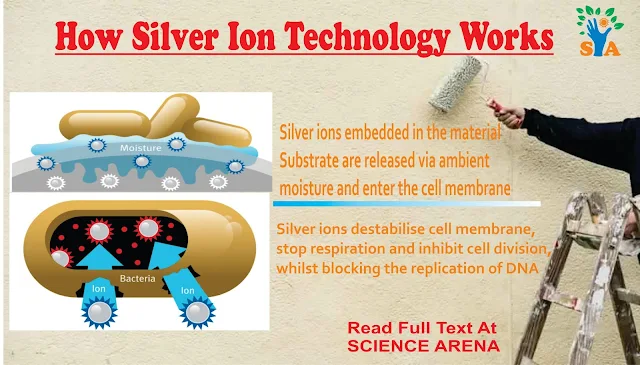Beautified living has been adapted by humans for ages. Painting homes, places of worship and work stayed as a cultural practice for long times. Early man who lived in caves and rock homes painted his home interiors with natural colours made from flowers and leaves. This grew up until using chemical preparations for painting interiors.
Markets look forward to more durable interior paints that can withstand wear and tears, varying climates and still stand environment-friendly. The durability of paint also accounts for its efficiency where it can stand with cleaning procedures of washing and wiping off with disinfectants. Efficient paint holds lustre with growing time.
Silver Boon for Health industry (RHS) Read Full text
These chemical constituents are exploited by microbes serving as feed and finally providing ecological niches as an outlet. Bacterial and fungal colonization is something very common on interior walls. Humans clean the wall surfaces with disinfectants and chemicals to remove hard stains. Most bacteria grow on moist surfaces and so the cleaning process followed by drying removes most microbes. Spores are dormant stages of bacteria and fungi. They remain inactive although whatever cleaning process has been adapted. They acquire an active stage in the advent of a favorable environment and proceed to develop colonies. Apart from this, using antibiotics and disinfectants for cleaning leads microbes to develop a certain level of antibiotic resistance which makes them further stronger.
Silver in its elemental form has antibacterial properties while it was later discovered that nano-sized particles have greater antibacterial properties because the total surface area increases within the specific volume as we go down on the nano-scale.
Going with silver as an antibacterial agent, can be in ionic, colloidal or nano-particle form. The bactericidal effect of silver is directly proportional to the number of silver ions released. Silver nano-particles (AgNP’s) have comparatively efficient biocidal effects accounting for the continuously releasing silver (Ag) ions. They are as small as 15nm in size and can enter into bacterial cells. AgNP’s release Ag ions into cellular interiors or they form clumps on cell walls and disrupt normal bacterial cell activities both of which turn fatal to bacteria. Reactive oxygen species generation is a feature of silver ion toxicity and the free radicals formed to interact with membrane proteins and DNA causing the dreadful impact in bacteria.
Vegetable oils are used in place of hazardous reducing agents and surfactants like sodium borohydride, hydrazine hydrate, alkyl amines, and alkyl phosphines, the current article describes the successful synthesis of silver nanoparticles via green synthesis by employing coconut, Indian gooseberry (amla), almond and mustard oils as capping as well as reducing agents. The presence of various fatty acids in such edible oils acts as capping agents through their carboxylic acid functionality and controls the growth of nanoparticles.
Vegetable oils possess high lubricity, high viscosity index, and low volatility which are excellent lubricating properties. Since the main drawback of vegetable oils is poor oxidation, much has been given in improving thermo-oxidation. In the present study, vegetable-based nano-lubricants by mixing Ag nanoparticles with different vegetable oils is prepared, this admix can be used as coating material having antibacterial characteristics.
Silver Boon for Health industry (RHS) Read Full text.
Disclaimer
We acknowledge the support and contribution of Asian Paints Limited in providing information for this article. The purpose of this article is to explain the scientific principles behind anti-bacterial paints.
All product specific views expressed here are my personal views. Readers should do their own research & consult professionals before purchasing the product.
Products may not function as intended if they are not correctly used. Please also refer to product guides provided by companies before purchasing the product as your purchase and use of the product will be governed by them.
For complete disclaimer and more information, please visit
The information provided in this article is just for the information of General Health. Science Arena Does not claim any health benefits nor are its authors in any form, all the data and information shown based on the personal experience and reference health data which is made public from the innovator/researcher.
Foot Notes
Markets look forward to more durable interior paints that can withstand wear and tears, varying climates and still stand environment-friendly. The durability of paint also accounts for its efficiency where it can stand with cleaning procedures of washing and wiping off with disinfectants. Efficient paint holds lustre with growing time.
Silver Boon for Health industry (RHS) Read Full text
Microbes – ubiquitous and can grow on walls too
Another promising goal is to withstand microbial flora that tends to grow on it. Microbes are ubiquitous and they tend to grow on walls too. Different kinds of bacteria, fungi, and moulds tend to grow on wall interiors of buildings. Interior wall paints are generally made of a wide range of carbon-based and non-carbon constituents (emulsifiers, glues, thickeners, and supporting materials) mainly for enhancing beauty.These chemical constituents are exploited by microbes serving as feed and finally providing ecological niches as an outlet. Bacterial and fungal colonization is something very common on interior walls. Humans clean the wall surfaces with disinfectants and chemicals to remove hard stains. Most bacteria grow on moist surfaces and so the cleaning process followed by drying removes most microbes. Spores are dormant stages of bacteria and fungi. They remain inactive although whatever cleaning process has been adapted. They acquire an active stage in the advent of a favorable environment and proceed to develop colonies. Apart from this, using antibiotics and disinfectants for cleaning leads microbes to develop a certain level of antibiotic resistance which makes them further stronger.
Silver as a biocide- all about what it does
Antimicrobial properties of silver are well known among the scientific world. Silver-based antimicrobial agents are popular for being less toxic to human cells, having high thermal stability and being less volatile.Silver in its elemental form has antibacterial properties while it was later discovered that nano-sized particles have greater antibacterial properties because the total surface area increases within the specific volume as we go down on the nano-scale.
Going with silver as an antibacterial agent, can be in ionic, colloidal or nano-particle form. The bactericidal effect of silver is directly proportional to the number of silver ions released. Silver nano-particles (AgNP’s) have comparatively efficient biocidal effects accounting for the continuously releasing silver (Ag) ions. They are as small as 15nm in size and can enter into bacterial cells. AgNP’s release Ag ions into cellular interiors or they form clumps on cell walls and disrupt normal bacterial cell activities both of which turn fatal to bacteria. Reactive oxygen species generation is a feature of silver ion toxicity and the free radicals formed to interact with membrane proteins and DNA causing the dreadful impact in bacteria.
Admix of Nano-Silver with Vegetable Oils
Vegetable oils are used in place of hazardous reducing agents and surfactants like sodium borohydride, hydrazine hydrate, alkyl amines, and alkyl phosphines, the current article describes the successful synthesis of silver nanoparticles via green synthesis by employing coconut, Indian gooseberry (amla), almond and mustard oils as capping as well as reducing agents. The presence of various fatty acids in such edible oils acts as capping agents through their carboxylic acid functionality and controls the growth of nanoparticles.
Vegetable oils possess high lubricity, high viscosity index, and low volatility which are excellent lubricating properties. Since the main drawback of vegetable oils is poor oxidation, much has been given in improving thermo-oxidation. In the present study, vegetable-based nano-lubricants by mixing Ag nanoparticles with different vegetable oils is prepared, this admix can be used as coating material having antibacterial characteristics.
Silver becomes the chieftain in the paint industry!!!
Common household paints contain oil-based binders and resins containing a wide range of polyunsaturated fatty acids. The paint resins undergo free radical-mediated autooxidation as a part of drying. Efficient anti-bacterial paints are prepared in such a way that they can release Silver nanoparticles (AgNP’s) during this drying process. The efficiency of silver-based anti-bacterial paint refers to its tendency in releasing AgNP’s. Since anti-bacterial properties of silver are well known throughout the scientific world, Silver-based anti-bacterial paints are popular. Silver-based anti bacterial paints have gained the crown for being less toxic to human cells, having high thermal stability and being less volatile. Silver nanoparticles (AgNP’s) have comparatively efficient biocidal effects accounting for continuously releasing silver (Ag) ions. They are as small as 15nm in size and can enter into bacterial cells later questioning their existence.Silver Boon for Health industry (RHS) Read Full text.
Conclusion
Customer expectation towards paint accounts for its durability and with ease of application as well. New Generation paints rely on naturally occurring auto-oxidation process that releases sufficient quantity of AgNP’s with lipids making it an environment-friendly anti-bacterial interior wall paint. The AgNP release does not require any heating process and requires simple air drying as the oils used to prepare admix is sufficient enough to reduce the metal ions. Asian Paints Royale Health Shield one of the ideal choices contains Silver Ion Technology as recommended* by the Indian Medical Association.We acknowledge the support and contribution of Asian Paints Limited in providing information for this article. The purpose of this article is to explain the scientific principles behind anti-bacterial paints.
All product specific views expressed here are my personal views. Readers should do their own research & consult professionals before purchasing the product.
Products may not function as intended if they are not correctly used. Please also refer to product guides provided by companies before purchasing the product as your purchase and use of the product will be governed by them.
For complete disclaimer and more information, please visit
The information provided in this article is just for the information of General Health. Science Arena Does not claim any health benefits nor are its authors in any form, all the data and information shown based on the personal experience and reference health data which is made public from the innovator/researcher.
Foot Notes
- The European Colloid and Interface Society (Colloidal Silver Soap)
- Green Synthesis of Silver Nano-Particles by Use of Edible Oils. (Kshirsagar A, Khanna T, Dhanwe V, Kate KH, Khanna PK.)
- Tribological and Thermal Transport of Ag-Vegetable Nanofluids Prepared by Laser Ablation Appl. Sci. 2020, 10(5), 1779; (https://doi.org/10.3390/app10051779)
- Silver-nanoparticle-embedded antimicrobial paints based on vegetable oil (ASHAVANI KUMAR1*†, PRAVEEN KUMAR VEMULA2†, PULICKEL M. AJAYAN1* AND GEORGE JOHN )
Author Details
 Gautam Singh Rathore
Gautam Singh Rathore

